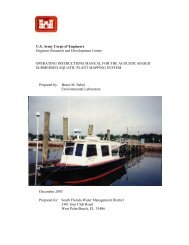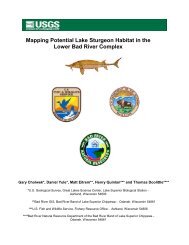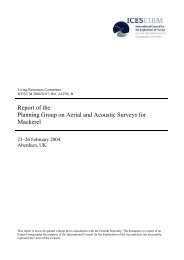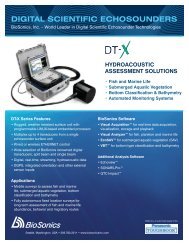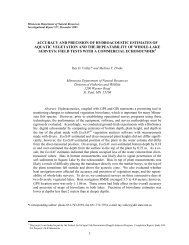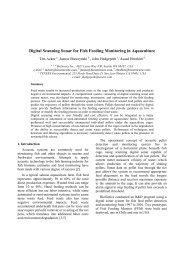Target Strength of Southern Resident Killer Whales ... - BioSonics, Inc
Target Strength of Southern Resident Killer Whales ... - BioSonics, Inc
Target Strength of Southern Resident Killer Whales ... - BioSonics, Inc
Create successful ePaper yourself
Turn your PDF publications into a flip-book with our unique Google optimized e-Paper software.
Code:46.2008-final-Feb9<br />
ranges between −7 to −13 dB. Most recently, Lucifredi and Stein (2007) reported an aspect-dependent<br />
gray whale TS measurement taken at about 500-m range using a vertical line array sonar frequency<br />
centered at 23 kHz. The reported TS measurements for adult gray whales ranged from −2.9 dB at tail<br />
aspect to 12.8 dB at broadside aspect. An active sonar system was used to study killer whale hunting<br />
behavior in Norwegian waters (Simila, 1997; Nottestad and Axelson, 1999; Nottestad and Simila, 2001;<br />
Nottestad et al., 2002a, 2002b). A comprehensive and relatively well-controlled experiment was<br />
conducted to insonify a tagged killer whale using two commercial active sonar systems (the Simrad<br />
Model SP90 (20-30 kHz) and Simrad Model SH80 (110 to 120 kHz), Kongsberg Maritime AS, Horten,<br />
Norway). The goal <strong>of</strong> the study was to evaluate the feasibility <strong>of</strong> using active acoustic systems to detect<br />
killer whales and observe their behavior in the L<strong>of</strong>oten fjords <strong>of</strong> Northern Norway (Kvadsheim et al.,<br />
2007). However, TS observations <strong>of</strong> killer whales, if obtained during this study, were not reported. Au<br />
(1996) measured the TS directivity at 67 kHz <strong>of</strong> a well-trained bottlenose dolphin in a pool like facility.<br />
He also insonified parts <strong>of</strong> the dolphin to identify the major contributors to whole body TS. Au observed<br />
relatively low TS for most portions <strong>of</strong> the dolphin's body with exception <strong>of</strong> strong echoes from the lungs.<br />
Au’s observations indicate that the air filled lung <strong>of</strong> whales, and presumably other marine mammals, is a<br />
major reflector <strong>of</strong> sound, which is similar to findings for fish that indicate that the swim bladder is the<br />
major reflector <strong>of</strong> sound in the species <strong>of</strong> fish that have one (Clay and Horne, 1994).<br />
The target strength measurements for large marine mammal at sea are very important but difficult to<br />
obtain. Usually, when these measurements are collected, they are most likely only for a specific animal<br />
and certain frequency and there are a lot <strong>of</strong> gaps that we need to fill before we can apply these<br />
measurements to practical applications. In this paper, we report the preliminary results <strong>of</strong> TS modeling<br />
we performed to extrapolate the TS measurements <strong>of</strong> bottlenose dolphin provided by Au (1996) to killer<br />
whales. We also report the results <strong>of</strong> analysis <strong>of</strong> echo data we acquired for three freely swimming killer<br />
4



